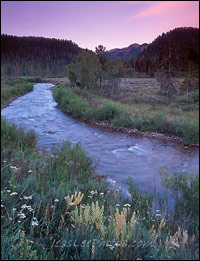On a summer weekend in the high country, I talked my grandmother into taking a drive into the Wyoming Range, where she’d worked with my grandfather as a hunting guide more than 20 years earlier. We wanted to have a look at a certain 44,600 acres of forest that had been leased by companies in search of natural gas.
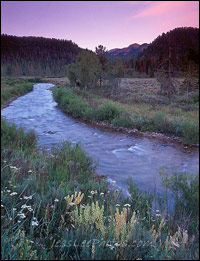
Can the Wyoming Range be protected
from drilling?
Photo: JessLeePhotos.com
Heavily timbered with pine, fir, and aspen, the range lies to the west of Pinedale, my hometown. The leased land fell across the Beaver Creeks, where Grandma had grown up on a tiny homesteaded ranch. The leases meant that all the country she and I were familiar with would be open to the potentially devastating development of rigs and roads and pipelines and wells. The development would take place a few short miles from where my grandmother’s family had settled, where she’d broken horses as a young woman, and where my family still held a single acre of land.
“The only time I saw a lynx that was alive in the wild was on this creek,” Grandma said as we drove along a dirt road. We were on Dry Beaver Creek, a tiny, winding stream that runs out of the mountains and disappears underground, leaving nothing but a bed of stones lined with stubbly willows and dry grass. The lynx, my grandmother said, had surprised her when he sprang out of a line of timber on the north side of the creek, less than a hundred yards from where she sat quietly in a pickup, waiting for a group of hunters to return. The animal had padded across the clearing and the creek and sat at the edge of the trees on the other side of the road, licking his paws and cleaning his face “just like a cat,” Grandma said.
Aside from lynx, these mountains were home to elk, deer, moose, bears, wolves, and all manner of birds. But we’d been talking about the Canada lynx because — along with some air-quality issues — it was a factor behind a motion made by a coalition of concerned citizens to halt the leases, at least temporarily. The leases had been granted on national forest land, based on a forest report more than a decade old — and in that time, the cat had become endangered. My grandmother’s story about the lynx hadn’t come from any hope that the forest could be saved, though. It was more a lament.
Later in the day, as we continued our drive, she told me that the biggest problem for residents of Sublette County as it faced massive development was a divergence of interests. “When you’ve got all these little groups pushing their own little things,” she said, “you’re just about wasting your time.”
The Drilling Fields
When we took that drive into the mountains, Sublette County was already undergoing a huge gas boom. In the high plains between the Wyoming Range and the Wind River Mountains, 30,000 acres were under frantic exploration. Pinedale was under intense pressure from an influx of rowdy workers and skyrocketing land prices. There was a dearth of help for local businesses; any able-bodied person with an ounce of sense would take the higher paying jobs in the gas field.
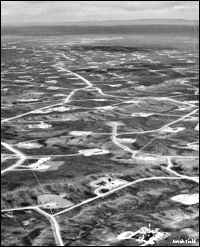
The scars of the Jonah Field.
Photo: Peter Aengst / The Wilderness
Society / Light Hawk
The year before, I’d come home and taken such a job in one of the largest of several gas fields in Sublette County, the Jonah. I had seen firsthand the damage such development brought with it. Once you turned off the highway, the Jonah Field became a cross-hatched mess of hard-packed roads, well locations, and greasy, groaning drilling rigs. There were so many roads to so many well sites that every roustabout in my company carried a map in the glovebox, and even then we sometimes got lost. The whole landscape was a scarred fiasco, and it was hard to see how it would ever go back to the way it once was.
At that time in my life, I had great sympathy for the people of Sublette County. I’d arrived in my own personal state of economic hardship, and I’d given in to the temptation of gas money. I found solace in the same excuses I heard from the people around me, that America’s “thirst for oil” was driving an energy demand that needed to be met from home. That environmentalists were protecting their solitude — and sometimes their glamorous homes — at the expense of jobs. And besides, nobody really ever went into that part of the country, so what was the harm?
But now that it looked like the Wyoming Range — and the Bridger-Teton National Forest on the range’s northeastern flank — might undergo some of the same industrial-strength lashing, the harm was becoming more apparent to more people.
That harm, of course, is that once you let big money in, it’s hard to slow down. A type of surrender ensues. People like my grandmother, and others in town, had succumbed to it. They’d become numb to warnings from different parties who wanted to stop the development — were wary and weary of them, in fact.
Even as I drove with Grandma through the Wyoming Range, I could see she loved the place, and her lynx story was a way of telling me so. But her lack of faith in people’s ability to change things wasn’t encouraging. It echoed the shoulder-shrugging indifference I’d grown used to in my time back home. The surrender of national forest to developers, though, looked like it might offer a wake-up call.
Won’t You Stay Just a Little Bit Longer
Public land in Wyoming, like much of the West, is managed at two different levels. The Bureau of Land Management, under the Department of the Interior, manages a lot of the sagebrushed steppe between the mountains, and the Forest Service, under the Department of Agriculture, oversees the national forests — at least on the surface. Put another way, the BLM got “the land that nobody wanted,” Steven Hall, a spokesperson for the bureau, told me.
In Sublette County, that meant most of the land currently under development was fully operated by the BLM. The Jonah alone, Hall said, was going to provide 8 trillion cubic feet of gas over 76 years, enough to heat 12 million homes for a full year. The Jonah would spur $30.5 billion in economic activity, he said, and would provide decades of work in development, production, and reclamation. Royalties would be around $6.1 billion, half of them going to the state. In other words, the gas under Sublette County was a massive resource for the nation and for locals, and it was the BLM’s job to maximize its capture.
“That’s our mission,” Hall said.
Now the BLM was looking for more. The Bridger-Teton land — at least where private companies suspected they might find natural gas — also fell under the aegis of the bureau, once it was approved for leasing by the Forest Service.
The Forest Service was aggressively following a “multiple use” mandate, one that called for the agency to find segments of land where gas might be exploited. At first, the Forest Service had come up with 156,000 acres of land in the Wyoming Range, but following a public outcry had reduced that to 44,600. The land was leased in four deals with private companies through the BLM.
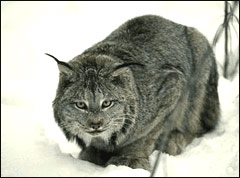
A catalyst in the form of a Canada lynx.
Photo: BLM
The leasing of the forest land had awakened groups heretofore unbothered by developments on the prairie. In June, a coalition formed that included locals, outfitters looking to protect their livelihoods, and groups such as Trout Unlimited, the National Outdoor Leadership School, and the Wyoming Outdoor Council. Together, they petitioned the Interior Board of Land Appeals — an oversight committee for BLM leases — for a stay on the leases, pending further review of factors such as the new status of the lynx and an increasingly hazy sky over the county — a result of other gas-field development unforeseeable in the past.
“The days of crystal blue skies are gone forever,” Gary Amerine, an outfitter, told me one night over cheeseburgers and Pepsi at a local restaurant in Pinedale. But, he said, it wasn’t too late to save the Wyoming Range, and the impacts of the Jonah Field might even help the cause. The plan was first to get a stay on the leases, and then petition to have the Wyoming Range protected by Congress from any kind of development in the future.
In September, a promising sign emerged. The IBLA granted a stay on a large parcel of land, bringing a temporary halt to the development of nearly 20,000 of the 44,600 acres.
The decision was a good sign that stays on the leases for the rest of the land would also be granted, Lisa McGee, an environmental lawyer for the Wyoming Outdoor Council, wrote me after the decision. “In other words … these stays will set a precedent for the remaining Wyoming Range lease sales — effectively halting new leasing in the Wyoming Range for the time being.”
I’d met McGee in Lander, Wyo., another small mountain town, at her office, in the only building on the street sporting solar panels. Before the IBLA decision, she’d told me in a derisive tone that the 44,600 acres — vast to many — had originally been considered a compromise. “We know that oil and gas contribute to our economy in this state, and it’s important,” she’d said. “But we do draw the line at some of these special places.”
The stays on the leasing, while gratifying, were a small victory. After all, the Wyoming Range isn’t protected now any more than it was prior to the decision, because a review of the land might still find it suitable for gas development. I could still hear Grandma’s despairing voice. “Waste of time,” it said.
But to McGee, the decisions were not only legally promising, they also said something about cooperation. “This decision says a lot about the power of citizens to stand up and demand that federal land managers follow the law,” she wrote. “It’s also encouraging to see people from different walks of life — hunters, anglers, oil and gas field workers, outfitters, ranchers, and conservationists — working together with a common goal: to keep oil and gas development out of the places where we recreate and spend time with our families.”
A Changing Place
Sublette County is home to about 6,000 people, most of whom are benefiting in one way or another from the gas boom. But money comes with a price. Violent crime is up, as is the use of drugs, Mary Lankford, Sublette County clerk, told me. The county sheriff’s department and the state highway patrol had an uphill battle keeping wages competitive with the gas money, and the town’s streets were constantly troubled with traffic, especially in the summertime, when tourists co-mingle with workers.
A lot of people were willing to deal with those growing pains, because so much money was coming in. On my morning jogs, for example, I’d pass a construction site for a $16 million “aquatic center,” one that would replace the old swimming pool where I’d learned to swim. Before the old pool, kids in sleepy little Pinedale, kids like my mother, had to learn to swim in Fremont Lake, where the waters, fed from glacial runoff, were freezing in all but the hottest summers.
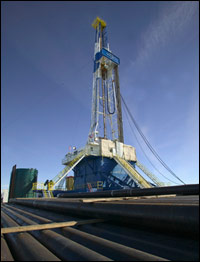
A drilling rig towers over the Pinedale Mesa.
Photo: Jeff Vanuga
Pinedale was anything but sleepy when I returned. It was inundated, and seemed to be foundering. I never got the sense while I was there that anyone was at the helm. Development was king, and people were overwhelmed.
During my stay, local primary elections transpired, and the Republican winners for county commissioner, one of the weightiest jobs in politics as local as these, were both men whose pro-drilling views were documented in a pre-election special section of one of the local papers, the Pinedale Roundup. Presumably, their views were those of the majority.
Asked whether he was an environmentalist and supported drilling on the forest, one of the two, Bill Cramer, told Roundup readers: “I care deeply about the environment. This is one reason I moved here. But I am also a realist. Oil and gas are where we find them. We cannot expect producers to provide us the energy if they cannot drill.”
A Bridger Over Troubled Water
To me, the real question was in the development of the Bridger-Teton. Why, I wondered, was this necessary when so much development was already under way on the prairie? And what kind of pressure was coming to bear on Forest Service administrators, people who presumably got into their jobs because they wanted to be stewards of the forest? Had the Wyoming Range become part of some larger deal-brokering? Had some forests been protected while others hadn’t?
“We can’t just say, ‘Sorry, not here,'” Teresa Trulock, a natural-resources specialist for the Forest Service, told me. “That’s a three-year-old’s argument.”
“You have to have a reason” not to turn land over to the BLM for leasing, she said. The Forest Service, as a federal agency, had requirements to review any land that private companies chose to explore for resources, she said. “Basically,” she said, “we have policies that are driven by law.”
The BLM asks for the land, and the Forest Service grants it. They are two agencies under different federal departments, making it easy for each side to put some responsibility on the other when the public starts looking for redress, each of them citing a “multiple use” strategy that seems to some a little lopsided.
“Multiple use doesn’t have to be every single acre on the forest,” McGee said when I met her at her office. “You don’t want to recreate in a place that looks like the Jonah Field.”
When I asked Trulock, who has lived in Pinedale for five years, how she felt personally about the new swath of land being leased, she said it would be outside her professional parameters to discuss. When I asked her if there was any resistance to the leasing inside the Forest Service, she said she wasn’t aware of any.
Meanwhile, the Forest Service recently began creating a new forestry plan — an expensive, time-consuming process that won’t be completed for two or three years, Trulock said. This plan, presumably, would recognize the endangered status of the lynx, and other changes since the last plan was drafted. But just because a new plan is under way doesn’t mean development stops. “You can’t come to a screeching halt,” Trulock said.
I understand that. And I also understand that development in the Jonah, while it is an eyesore, is helping a lot of people. Pinedale is never going to be as it was when I was a kid. It is going to grow. The skies won’t stay clear forever. My concern, though, is that the Wyoming Range is going to start to look like the Jonah: cut up, trampled down, a thoroughfare for gas-field traffic — not a sanctuary for red-tailed hawks and secretive lynx.
I asked Trulock if there was a chance that the 44,600 acres on the forest would look like the Jonah. She told me she hadn’t actually seen the Jonah, exactly, “except from the highway.”
